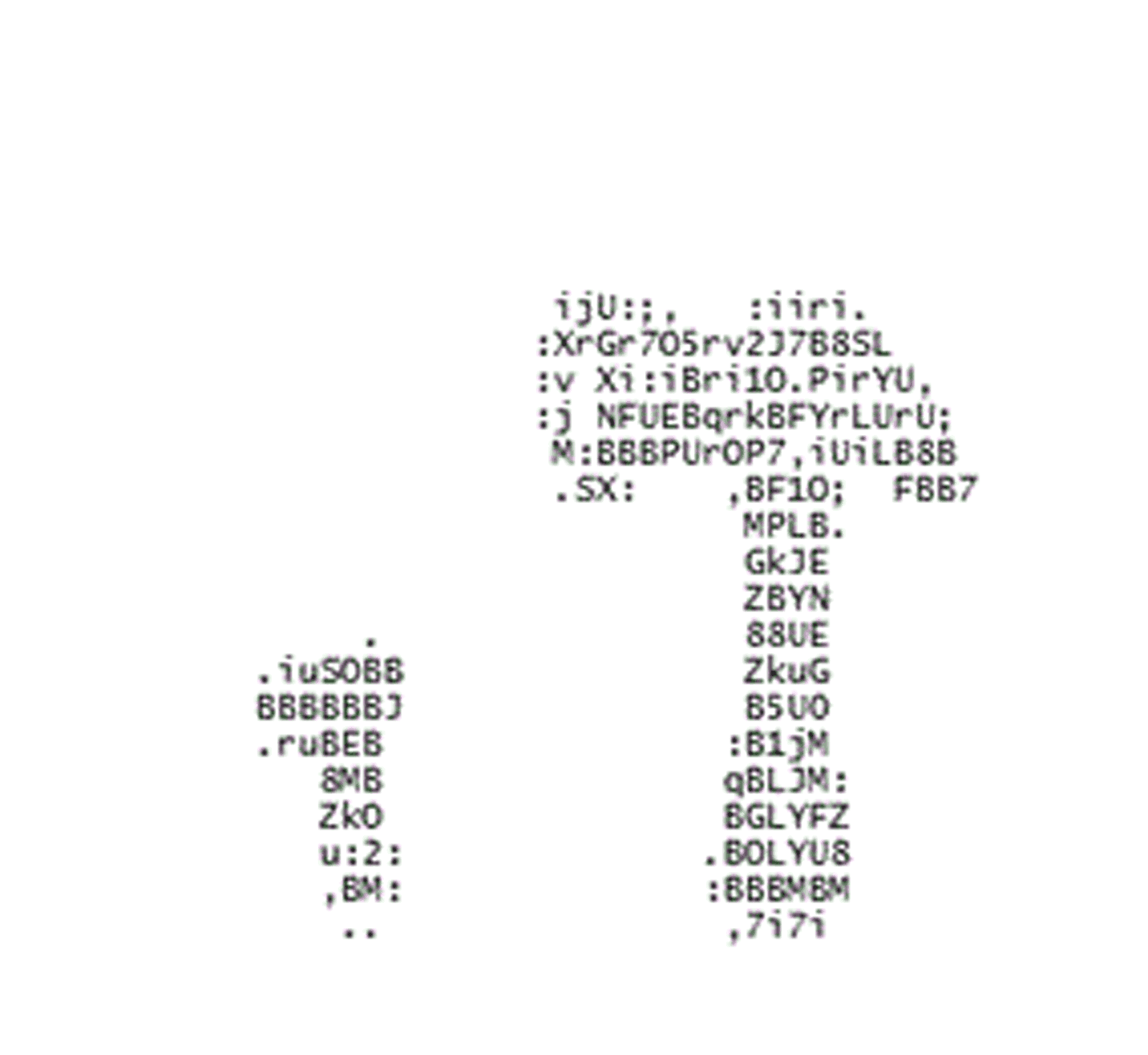Michelle Santiago Cortés: Font Hacks


For this special guest takeover of The Dinamo Update, we’re joined by Michelle Santiago Cortés. She takes us on a journey from font hacks and their (still raw) Unicode origins to ASCII and 𝓰𝓲𝓻𝓵𝓫𝓵𝓸𝓰𝓰𝓮𝓻, and how these keep the early internet alive.


Michelle Santiago Cortés is a Puerto Rican writer and editor who just moved back to Brooklyn. She regularly writes for ArtReview, Lux Magazine, and The Cut. Unfortunately, you can find her and keep up with her work on Instagram and Twitter. Let’s follow her to the unicoded edges of the internet.
Letterlike: Font Hacks at the Periphery of the Internet
You know you’re getting closer to the warm, wet depths of the internet when the signs begin to wobble. When Instagram starts displaying text that looks like it’s been italicized, turned upside down or even written backwards. When a platform’s clean, proprietary font starts looking slanted, with curled edges; or thicker, with a stalkier base. If you’re drifting towards its peripheries, the diacritics will be the first signs. There, you’ll find the non-Latin alphabets, where Cyrillic, Japanese or Polish come into greater prominence, one character at a time. Meme pages, fan accounts, smut posters, and aesthetic bloggers are some of the primary agents of this kind of typographic chaos. They carry the torch of a once-ubiquitous internet trend – the use of font hacks – by continuing to make their profiles cuter, sparklier, spookier or otherwise more customized despite (and increasingly, in pursuit of) the wobbly results.

Creators like @the.ontological.turnt or @everyoneisagirl, and even artists like Maya Man, keep it modest with standalone stars and asterisks that look like something pulled from behind the symbols section of the emoji keyboard – pixelated or out of line with the main text. On the other hand, medieval mysticism meme account @marymagdalenestan opted for a more confrontational approach, its display name written in thorny Gothic lettering that says: “Christendom hates her.” Font hacks are also at work wherever you see someone spell their name using Korean or Arabic characters on a platform set to English. And they’re especially noticeable when a user combines multiple font hacks into mishmashes like the now-ubiquitous sparkle bow: ⋆୨୧˚. Collectively, font hacks signal nostalgia and reference the early internet, harking back to a time when such characters and typographic quirks were par for the course of customized internet profiles.


If you’ve ever tried to reverse-engineer these effects, you’ve probably run into browser-based generators that let you either design your own font or transform a text of your choice into a stylish cursive version you can copy and paste into your profile or posts. On YouTube, you can learn how to add “Unicode fonts” to your smartphone’s keyboard, as we once did with emojis, from a video bookended by fan edits of Aespa’s Giselle, the Japanese member of SM Entertainment’s most popular idol girl groups. While they are most often identified as “fancy fonts” or “font hacks,” these aren’t fonts at all. And they’re not “hacks” either, as they don’t require the circumvention of any proprietary system or digital lock. In fact, the possibility and availability of such “fancy fonts” would not be possible without one of the internet’s greatest institutions: the Unicode Consortium.



Founded in 1988, Unicode facilitates computer interoperability across languages by developing a standardized system that gives each character its unique code points. If that doesn’t mean anything to you now, consider the following: Where you see the pictogram of a sealed envelope on your screen, your computer “sees” instructions to open your inbox; where you see a paper plane, your email’s hosting service “sees” a command to send mail. Where you see sentences, words and letters, a computer “sees” the string of numbers (code points) that put them there. For most of the 20th century, computers only “spoke” English (and they mostly still do). The American Standard Code for Information Interchange (ASCII) was the lingua franca of computation, but it only accounts for 128 total characters including: 31 commands, all 10 digits, a handful of punctuation marks, some mathematical symbols, and the 26 letters of the English alphabet in both lower and upper case. The standard assigns each character a code point from 0 to 127, and each character could then be translated into 7-bit strings of binary digits using a hexadecimal table to determine the value – 0 or 1 – of each bit. ASCII was useful and successful because it was economical with storage, which meant it was cheap and fast. But it wasn’t scaleable and my mother’s family wouldn’t be able to spell its last name (Cortés) with it.


Even though ASCII could rely on British and American hegemonic power to impose itself on the world of computation and, increasingly, computer usage, Unicode has and continues to make it possible for other languages to get a slice of the pie. The consortium created a standardization system that assigns code points to all those “special characters,” like diacritics, non-Latin scripts, dingbats, and increasingly, emojis. Unicode managed to create a standard that was backwards compatible with ASCII and is also able to theoretically accommodate just over 1.1 million characters. While it’s barely cracked through 300,000 as of 2024, it is already the premier character encoding standard of the internet.

But, Unicode’s website clearly states that “the Unicode Standard does not address the representation of rich text,” meaning, text with added instructions about style or color is none of Unicode’s business. What is sometimes called a “Unicode font” is technically any computer font whose glyphs are assigned code points according to UTF-8. But, sometimes style is substance, and the consortium assigns code points to specific transformations – some instances of italics or bold – that alter a glyph’s meaning enough to be considered an other, separate glyph. If you were using a computer to write a paper on the the Pythagorean theorem (𝒶2 + 𝒷2 = 𝒸2), it helps to be able to distinguish between a regular “a” and the variable 𝒶.
What we call “fancy fonts” are more a DIY workaround that mines all 300,000 standardized characters for graphemes and glyphs that can be repurposed into upside down, double-struck, or bolded Latin letters. They ignore what the computer sees by prioritizing what we see. The cursive script beloved by 𝓰𝓲𝓻𝓵𝓫𝓵𝓸𝓰𝓰𝓮𝓻𝓼 is technically compiled from a list of script symbols “to be used for mathematical variables where style variations are important semantically.” Most of our favorite “fancy” characters are either “letterlike symbols” or “mathematical alphanumeric symbols.” If you were writing these characters with your hand or reading them with your eyes, you wouldn’t need standardized code to tell the difference between “a” and “𝒶.” But they are encoded distinctly because a computer (and a screen reader!) doesn’t know the difference.



In tracing the history of how that sexy Gothic lettering also known as 𝕱𝖗𝖆𝖐𝖙𝖚𝖗 was standardized by Unicode, I came across a 2013 discussion board where consortium members discussed the very possibility that “naive users” might “use them for text.” But font hack users are going out of their way to source these stylized characters, going as far as perverting a number of non-Latin alphabets for shapes that can be used as b’s or c’s. Naive they are not. And it’s a good thing for these small miracles of interoperability to be available to those who want to angle for a very specific kind of visibility, one that can fool computers and create its own audience.
Like kaomoji (٩(◕‿◕。)۶), ASCII art, and punctuation-based emoticons, “fancy fonts” recall a too-easy-to-romanticize internet epoch, when a lack of standardization and minimal commodification kept the workings of the machine closer to the interface. In the forums, emails and chat rooms of the early net, our wet human eyes looked at the QWERTY keyboard’s numbers, symbols, and graphemes and saw those shapes take on new forms: the colon learned to stare, and the hyphen began to smell. The “X” came together as eyes squinting in excitement and the “D” embodied the primal joy that follows an affectionate utterance of the word: “rawr!” This genealogy hides in text fields across interfaces like iMessage and Gmail, where you can type in a colon + closing parenthesis and watch “:)” transform into a smiling emoji rendered in multiple colors and shaded details. The font hack resists this.


These early internet glyphs are choppy and gestural, like the Paleolithic paintings of the caves of Lascaux. And while it’s tempting to hierarchize these forms along a progressive timeline that evolves towards photorealism, it would be tragically myopic to write off these early ancestors as half-baked or less-than versions of an idealized form. Fancy fonts endure because there are some things that only a pseudo-hack can do. There is a nuance to the meaning that can only be conveyed by a character that is not quite a letter. The word “girlblogger” feels like it can be more accurately spelled as “𝑔𝒾𝓇𝓁𝒷𝓁𝑜𝑔𝑔𝑒𝓇.”
- The End -




